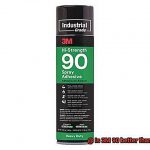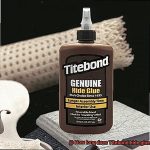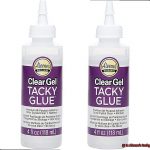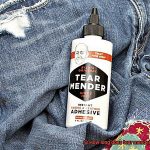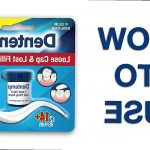Are you tired of wimpy adhesives that can’t handle the toughest tasks? Well, get ready to meet your new adhesive superhero: E6000 glue. This bad boy has built up a serious fan club thanks to its insane strength and crazy versatility.
Whether you’re a DIY wizard, a craft fanatic, or just someone who likes fixing stuff around the house, E6000 glue promises to be your go-to adhesive. But does it actually deliver on its promises? That’s what we’re here to find out. In this post, we’ll put E6000 glue under the microscope and give you the lowdown on its performance.
So buckle up, folks. We’re about to dive deep into the world of E6000 glue and see if it lives up to all the hype. Get ready for an adhesive adventure like no other.
What Is E6000 Glue?
Contents
What sets this glue apart from others on the market is its remarkable strength and durability, making it a go-to choice for a wide range of projects.
One of the most impressive features of E6000 glue is its ability to bond different types of materials together. Whether you’re working with metal, glass, fabric, or ceramics, this adhesive can securely hold them in place. Its effectiveness on porous surfaces is particularly noteworthy, as it forms a bond that stands the test of time.
Durability is where E6000 glue shines. Once fully cured, it can withstand heavy loads and resist impacts, making it suitable for both light-duty and heavy-duty applications. Whether you’re creating delicate jewelry or tackling industrial projects, this glue can handle it all with ease.
Another advantage of E6000 glue is its resistance to temperature changes and moisture. It dries to a flexible and waterproof finish, allowing you to confidently use it indoors and outdoors. No need to worry about your project falling apart due to exposure to harsh conditions.
However, it’s important to note that E6000 glue does have a strong odor, so using it in a well-ventilated area is crucial. Additionally, once the glue has dried, it can be challenging to remove from surfaces. Therefore, it’s wise to take precautions and clean up any spills or excess glue immediately.
Benefits of Using E6000 Glue
Finding the perfect adhesive is crucial for any crafting or DIY project, and E6000 glue is a superhero among adhesives. This remarkable adhesive offers a myriad of benefits that will revolutionize your creative endeavors. From its unparalleled bonding power to its versatility, E6000 glue is a game-changer in the world of crafting. Let’s dive into the exciting world of E6000 glue and explore why it should be your go-to adhesive for all your projects.
Unmatched Bonding Power:
E6000 glue is renowned for its exceptional bonding power, making it perfect for projects that require long-lasting adhesion. It bonds effortlessly with an extensive range of materials, including metal, wood, glass, fabric, ceramics, and more. This adhesive forms a strong and durable bond that can withstand heavy loads and resist impact, ensuring that your creations remain intact and secure.
Flexibility at Its Finest:
Unlike many other glues, E6000 offers excellent flexibility once cured. It can withstand bending or flexing without cracking or breaking the bond. Whether you’re attaching jewelry findings or repairing flexible materials like shoes or handbags, E6000 glue ensures that your projects remain intact and flexible. It adapts to the natural movements of your materials, providing a reliable bond without compromising their integrity.
Defying the Elements:
E6000 glue is no stranger to the elements. Once fully cured, it becomes waterproof, allowing you to use it for outdoor projects or in areas prone to moisture. Whether you’re creating garden decorations or repairing outdoor furniture, E6000 glue will withstand rain, snow, and humidity without compromising its bonding strength. Additionally, it can tolerate extreme temperature fluctuations ranging from -40°F to 180°F (-40°C to 82°C), ensuring that your bond remains strong even in harsh weather conditions.
Time on Your Side:
One of the key advantages of using E6000 glue is its long working time. Unlike fast-drying adhesives that leave little room for error, E6000 glue gives you ample time to position your materials correctly and make any necessary adjustments before it sets. You can take your time to align intricate pieces or experiment with different arrangements without feeling rushed. This feature is particularly beneficial for projects that require precision or multiple adjustments before achieving the desired result.
User-Friendly and Versatile:
E6000 glue is designed with the user in mind. It has a low odor compared to many other industrial-strength adhesives, making it more pleasant to work with, especially in indoor environments with limited ventilation.
Additionally, it dries clear, leaving no visible residue behind. This makes it ideal for working with transparent or light-colored materials, enhancing the overall appearance of your finished project. Whether you’re creating delicate jewelry or intricate glass art, E6000 glue seamlessly blends into the background, allowing your craftsmanship to shine.
The Advantages of E6000 Glue
E6000 glue is the ultimate solution for all your crafting and repair needs, thanks to its exceptional bonding strength and numerous advantages. Let’s explore the key benefits of this versatile adhesive.
- Versatility: E6000 glue can bond to a wide range of materials, including metal, wood, plastic, glass, fabric, and more. This eliminates the need for multiple adhesives and allows for seamless transitions between different projects.
- Flexibility: Once cured, E6000 glue remains flexible, making it perfect for applications that require movement or vibration resistance. It can withstand impacts and movements without cracking or breaking, making it ideal for attaching jewelry findings to fabric or bonding materials that may expand or contract.
- Durability: E6000 glue forms a strong bond that stands the test of time. It creates a permanent bond that is difficult to break, ensuring long-lasting repairs and projects that require a reliable adhesive.
- Water and Temperature Resistance: E6000 glue is resistant to water and extreme temperatures. It can withstand hot and cold temperatures without losing its adhesive properties. This makes it suitable for both indoor and outdoor use, as well as for applications exposed to moisture or fluctuating temperatures.
- Gap-Filling Properties: E6000 glue offers excellent gap-filling properties, allowing it to fill in gaps and uneven surfaces. This ensures a strong and secure bond even in challenging applications, making it particularly useful for bonding irregularly shaped objects or surfaces.
- Clear Drying: E6000 glue dries clear, providing a clean and invisible bond. This feature allows it to blend seamlessly with the materials being bonded, enhancing the overall appearance of the project or repair.
- Ease of Use: E6000 glue comes in a convenient squeeze tube or applicator bottle, allowing for precise application without the need for additional tools. Its thick consistency prevents messy drips or runs, making it user-friendly even for beginners.
- Long Shelf Life: When stored properly, E6000 glue can last for years without losing its adhesive properties. This makes it a cost-effective option for those who use adhesive frequently or for sporadic projects and repairs.
Uses of E6000 Glue
E6000 glue is a powerhouse adhesive that can revolutionize your crafting and DIY projects. This versatile adhesive is beloved by crafters, DIY enthusiasts, and professionals for its exceptional bonding capabilities and wide range of applications.
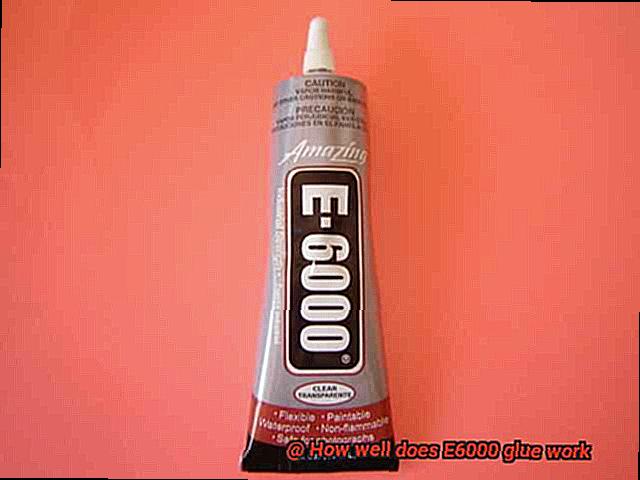
One of the standout features of E6000 glue is its ability to bond to almost any material. Whether you’re working with glass, metal, wood, plastic, or fabric, this adhesive has got you covered. Its strong bond ensures that your project will stay intact, even when faced with high-stress situations.
But the benefits don’t stop there. E6000 glue is also resistant to water and extreme temperatures, making it ideal for both indoor and outdoor projects. Say goodbye to worrying about your creations falling apart in the rain or melting under the scorching sun.
In addition to its incredible bonding strength, E6000 glue possesses remarkable gap-filling properties. It effortlessly bonds uneven surfaces and fills in gaps, providing a strong and seamless result. No more frustration over finding the perfect adhesive for those tricky projects.
The aesthetics of your projects are equally important. E6000 glue dries clear, leaving behind a professional and invisible finish. No more unsightly glue lines ruining the look of your beautiful creations.
Ease of use is another reason why E6000 glue is a go-to choice for many. With its convenient squeeze tube or applicator bottle, you can apply the glue precisely without any messy drips or runs. It’s a breeze to work with, saving you time and frustration.
Furthermore, E6000 glue boasts a long shelf life, ensuring that it’ll be there whenever inspiration strikes. No more wasting money on adhesives that dry up before you even have a chance to use them.
How to Apply E6000 Glue
Proper application is essential when using E6000 glue to achieve the best results. Whether you’re working on a craft project or fixing something around the house, following the correct application process will ensure a strong and durable bond. So, let’s dive into the steps you need to take to apply E6000 glue effectively.
Step 1: Gather your materials
Before you start applying the glue, make sure you have everything you need. Grab your E6000 glue, a clean and dry surface, disposable gloves, and find a well-ventilated area to work in. Having all your materials ready will make the application process smoother.
Step 2: Prepare the surface
To ensure a strong bond, it’s crucial to prepare the surface before applying the glue. Imagine a canvas that needs to be clear of any imperfections before a masterpiece can be painted on it. Clean the surfaces you want to bond with a mild detergent, removing any dirt, oil, or debris that could compromise the effectiveness of the glue. This step is like laying down a solid foundation for your project.
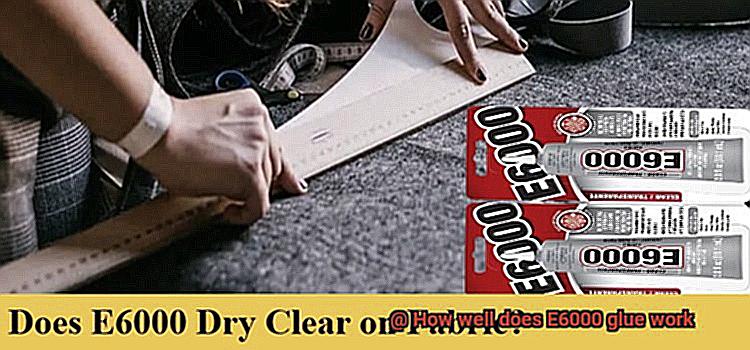
Step 3: Wear disposable gloves
Protect your skin by donning disposable gloves during the application process. E6000 glue is a powerful adhesive that means business, but it can also cause irritation if it comes into contact with your skin. By wearing gloves, you’ll keep your hands safe and avoid any potential discomfort, allowing you to focus on creating without worry.
Step 4: Apply a thin and even layer of glue
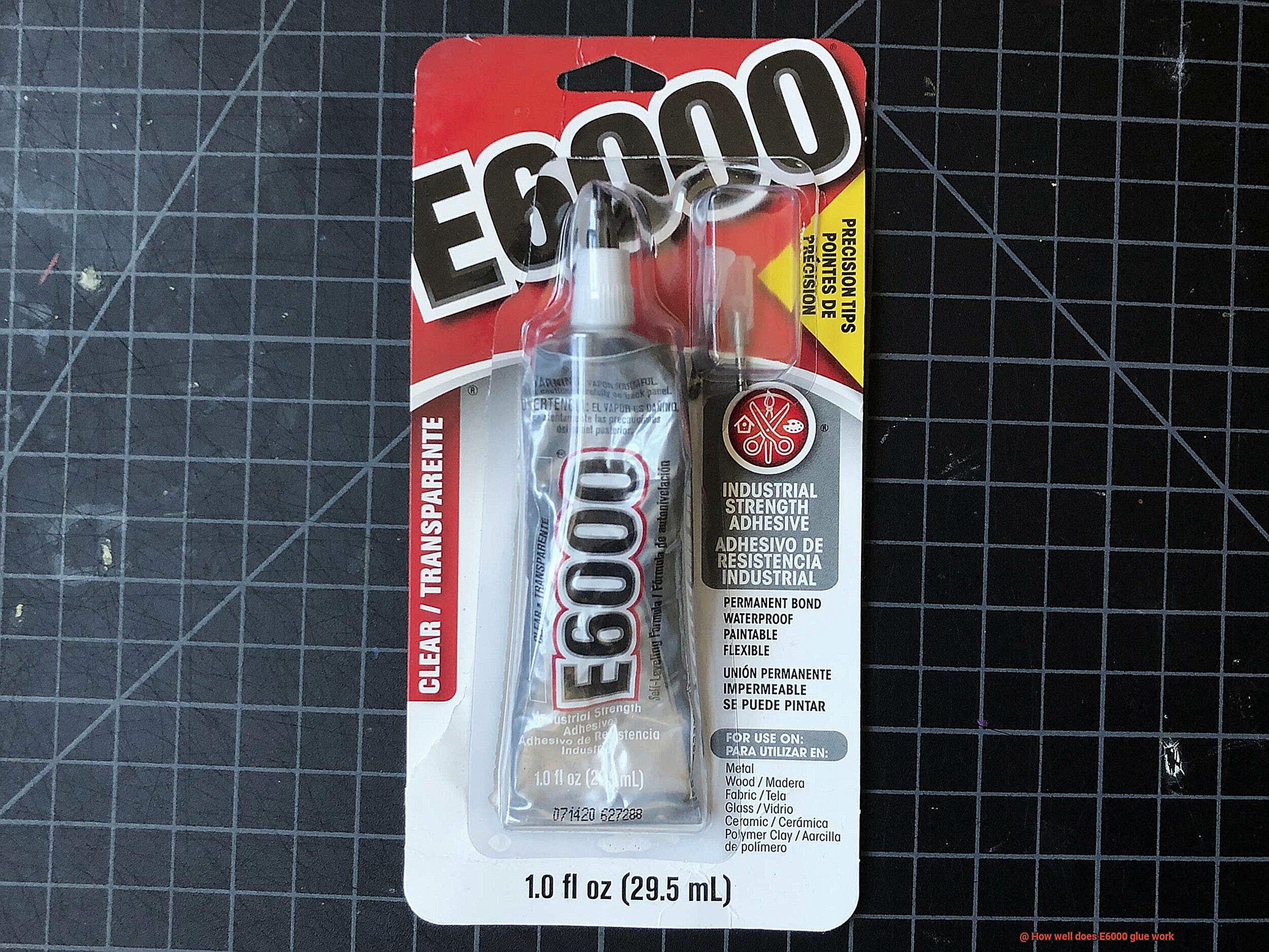
Now it’s time to unleash the magic of E6000 glue. Just like an artist delicately applies paint onto their canvas, use a small amount of this adhesive as it packs a serious punch. The tiniest dab can go a long way. You can use the nozzle of the tube to spread the glue evenly or opt for a toothpick or small brush for more precise application. Think of this step as the fine brush strokes that bring your masterpiece to life.
Step 5: Press surfaces firmly together
Once you’ve applied the glue, bring the two surfaces together and press them firmly. Imagine the satisfying click of puzzle pieces fitting perfectly into place. Make sure they are aligned correctly before pressing, as the glue forms a strong bond quickly, leaving little room for adjustment. Apply constant pressure for at least 24 hours to allow the glue to fully cure. This step is like applying the finishing touches to your creation, ensuring that it stands the test of time.
Step 6: Provide additional support if necessary
For larger or heavier objects, you may need to provide additional support while the glue cures. This can be done by using clamps, tape, or any tools that keep the bonded surfaces in place until the glue has completely dried. This extra support acts as scaffolding, guaranteeing a strong and secure bond.
Potential Drawbacks of E6000 Glue
Well, before you reach for that trusty tube of E6000 glue, let’s take a moment to explore its potential drawbacks. While E6000 glue is undoubtedly popular among crafters and artists, it’s essential to consider both the pros and cons before embarking on your next project.
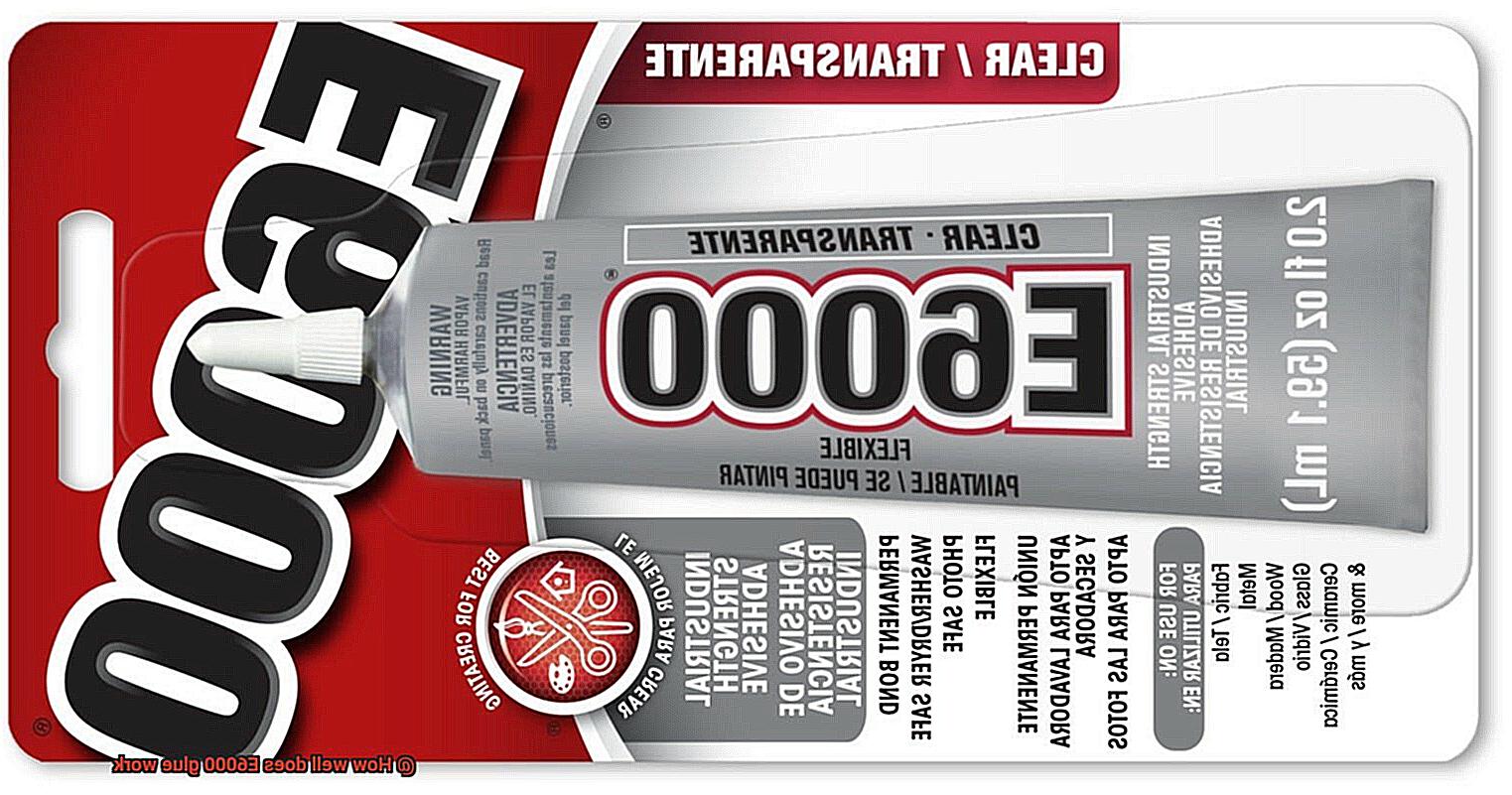
First and foremost, let’s talk about the elephant in the room: the strong odor of E6000 glue. Picture yourself hunched over your workbench, completely absorbed in your masterpiece, when suddenly a pungent smell engulfs your senses. Not exactly ideal, right? To avoid getting a headache from the fumes, be sure to work in a well-ventilated area or take regular breaks to clear the air.
Another drawback worth noting is the lengthy curing time of E6000 glue. If you’re someone who craves instant gratification or needs to keep working on your project without delay, this adhesive might test your patience. It’s important to remember that good things come to those who wait when using E6000 glue.
Now, let’s dive into the realm of water resistance. Unfortunately, E6000 glue is not waterproof. So, if you’re planning on venturing into the great outdoors with your creations or need an adhesive that can withstand moisture, it may be wise to seek an alternative option.
But wait, there’s more. Did you know that E6000 glue can become brittle over time when exposed to UV light? That means if your project will bask in the sun or be under bright lights, you might need to reapply the glue or reinforce it periodically to maintain a sturdy bond.
Speaking of aesthetics, some users have reported visible residue or yellowing on certain surfaces after using E6000 glue. This issue is especially apparent on clear materials like glass or plastic. So, if the appearance of your project is of utmost importance, it’s crucial to conduct a small test on an inconspicuous area before committing to E6000 glue.
Oh, and let’s not forget about compatibility. E6000 glue is not compatible with all materials. Styrofoam lovers, beware. This adhesive has the potential to cause damage or melting. To avoid disaster, always double-check the compatibility of the glue with your chosen surface before applying.
Lastly, once E6000 glue has cured, it is not easily removable. So, if you make a mistake or need to disassemble your project in the future, be prepared to put in some extra elbow grease and use specialized solvents to dissolve the glue.
Tips for Getting the Best Results with E6000 Glue
E6000 glue is a popular adhesive known for its strength and versatility. Whether you’re working on crafts, DIY projects, or industrial applications, getting the best results with this glue is essential. In this blog post, we’ll explore some tips to help you achieve strong and durable bonds with E6000 glue.
Start with clean surfaces:
Before applying E6000 glue, make sure the surfaces you’re bonding are clean and free from dirt, dust, or grease. Use a mild detergent or rubbing alcohol to clean the surfaces thoroughly, and allow them to dry completely before proceeding. This ensures that the glue adheres properly and creates a strong bond.
When it comes to bonding surfaces, cleanliness is key. Any debris or contaminants on the surface can prevent the glue from adhering properly and compromise the strength of the bond. By taking the time to clean the surfaces beforehand, you’ll ensure that the glue has a clean surface to grip onto, resulting in a stronger bond.
Use in a well-ventilated area:
E6000 glue emits strong fumes that can be harmful if inhaled in large quantities. To minimize exposure to these fumes, it’s recommended to use the glue in a well-ventilated area or outdoors. Open windows or use a fan to improve air circulation while working with the glue.
Ventilation is crucial when working with E6000 glue due to its strong odor and potentially harmful fumes. By working in a well-ventilated area, you’ll reduce your exposure to these fumes and create a safer work environment for yourself.
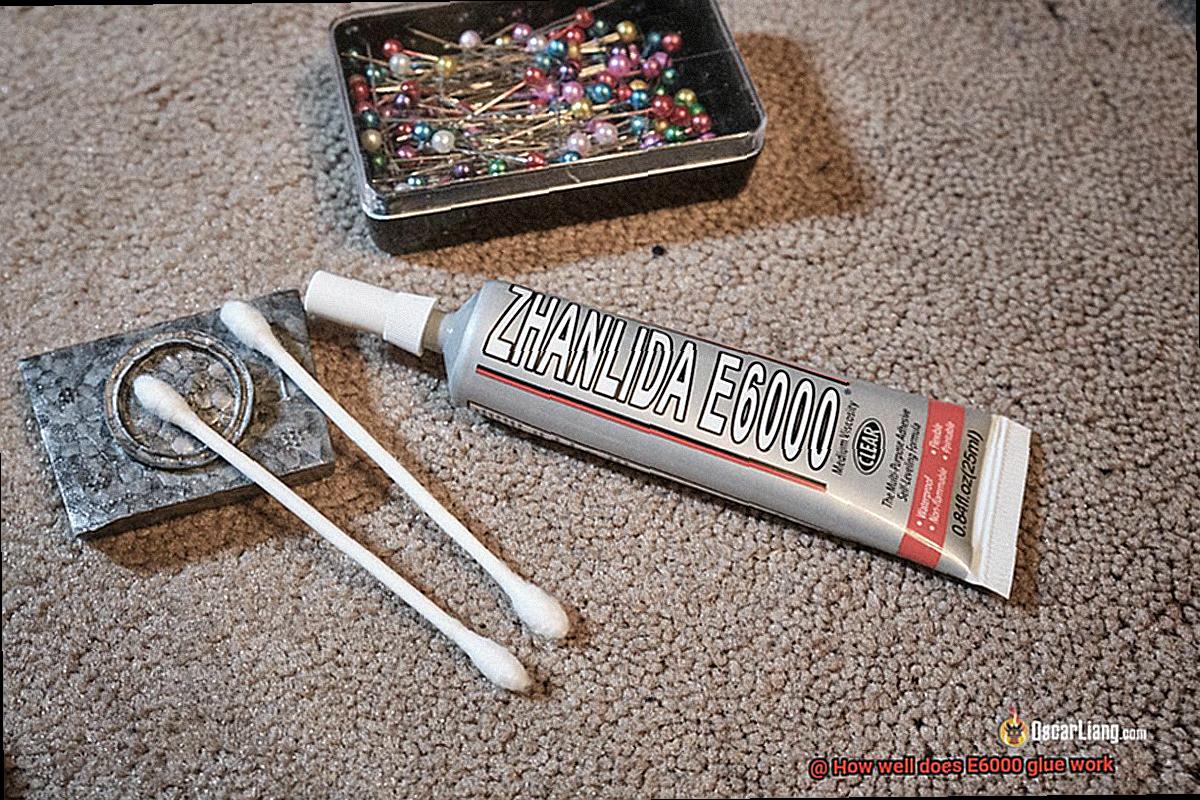
Apply a thin, even layer:
To get the best results with E6000 glue, apply a thin and even layer of adhesive. Use a small brush or toothpick to spread the glue evenly on one of the surfaces you’re bonding. Avoid using too much glue as it may result in longer curing times and weaker bonds.
Less is more when it comes to applying E6000 glue. Applying a thin and even layer ensures that the glue spreads evenly across the surface, maximizing its adhesive properties. Using too much glue can lead to messy results and longer drying times, so be conservative with your application.
Allow proper curing time:
E6000 glue requires adequate curing time to achieve maximum strength. After applying the glue, join the two surfaces together and hold them firmly in place for at least 24 hours. Keep in mind that curing times may vary depending on factors such as temperature and humidity, so refer to the product instructions for specific guidelines.
Patience is key when it comes to E6000 glue. While it may be tempting to test the bond or move on to the next step, allowing the glue to cure for the recommended time ensures that it reaches its maximum strength. Rushing the curing process can result in weaker bonds and compromised durability.
Cleaning Up Excess or Spilled E6000 Glue
E6000 glue, renowned for its robust bond and durability, can sometimes leave behind a messy situation. But fear not. As an expert in the field, I am here to walk you through the steps of cleaning up excess or spilled E6000 glue.
Time is of the essence when dealing with E6000 glue spills. Act quickly to prevent it from drying and becoming more challenging to remove. Now, let’s dive into the cleaning process:
- Swiftly wipe away: Begin by gently wiping away as much excess glue as possible using a clean cloth or paper towel. Be cautious not to rub or smear the glue, as this could spread it further.
- Scrape off dried glue: If the excess glue has already dried, utilize a scraping tool like a plastic scraper or an old credit card to carefully remove the hardened adhesive. Exercise caution not to scratch or damage the surface you are working on.
- Solvents with care: Rubbing alcohol or acetone can be effective in removing dried E6000 glue. However, they should be used judiciously and in a well-ventilated area. Apply a small amount of solvent to a clean cloth and gently dab at the dried glue until it starts to soften. Continue wiping away the glue until it is completely eliminated. Always perform a patch test on an inconspicuous area first to ensure they won’t cause any harm.
- Tackling fabric: Should E6000 glue land on fabric, allow it to dry before attempting removal. Once dry, cautiously scrape off as much of the hardened glue as possible with a scraping tool. Then, apply a small amount of rubbing alcohol or acetone to a clean cloth and gently dab at the remaining residue until it begins to loosen. Keep dabbing and wiping until every trace of glue vanishes.
- Razor blade for hard surfaces: When dealing with hard surfaces such as glass or metal, a razor blade can be employed to carefully scrape away excess or dried E6000 glue. Exercise caution not to apply too much pressure that could scratch the surface.
- Applying heat: In certain cases, heat can aid in softening and removing excess E6000 glue. Employ a hairdryer to gently warm the glue, making it easier to scrape off or wipe away. Once again, be mindful not to overheat or damage the surface.
- Commercial adhesive removers: If all else fails, specialized commercial adhesive removers designed for tough glues like E6000 are available. Follow the manufacturer’s instructions and precautions when using these products.
b2Dd2_BjEWY” >
Conclusion
The effectiveness of E6000 glue is truly remarkable. It surpasses expectations with its exceptional adhesive properties and versatile applications. This reliable adhesive bonds various materials together with ease, making it a go-to choice for crafters, DIY enthusiasts, and professionals alike.
E6000 glue’s superior strength ensures that your projects stay securely intact. Whether you’re working on jewelry, ceramics, fabric, or even metal, this glue forms a durable bond that withstands the test of time. Its incredible holding power gives you peace of mind knowing that your creations will remain intact for years to come.
Not only does E6000 glue excel in its bonding capabilities, but it also boasts excellent flexibility. Unlike other glues that may become brittle or crack over time, this adhesive maintains its elasticity even after drying. This means that your glued objects can still flex and move without compromising their bond.
One of the standout features of E6000 glue is its resistance to water and extreme temperatures. It remains steadfast even when exposed to moisture or heat, making it ideal for both indoor and outdoor projects. Whether you’re creating garden ornaments or repairing household items, this glue can handle it all.
Additionally, the application process is a breeze with E6000 glue’s user-friendly formula. Its thick consistency allows for precise control during application, preventing messy mishaps. The glue dries clear and quickly, leaving behind a seamless finish that enhances the overall aesthetic of your project.
In conclusion, E6000 glue is an exceptional adhesive that lives up to its reputation. Its strong bonding capabilities, flexibility, water resistance, temperature resilience, and easy application make it a top choice among crafters and professionals alike.


